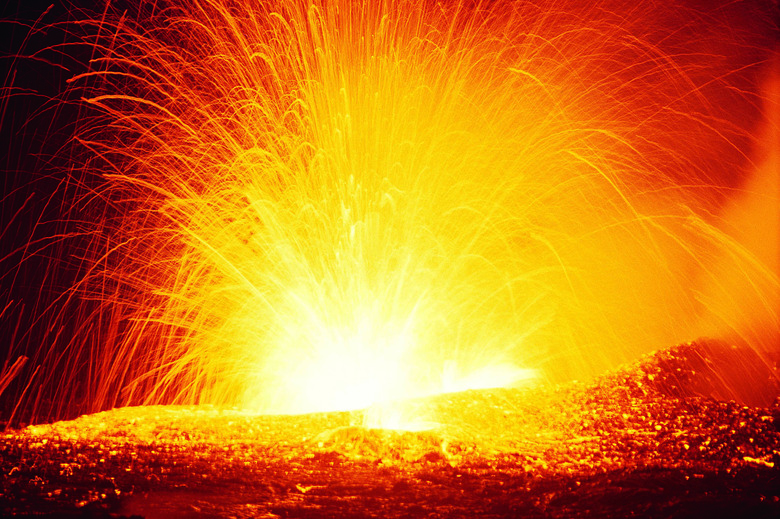Three Types Of Stress On The Earth's Crust
Three types of unequal stress on the Earth's crust are compression, tension, and shear. Stress arises because the fractured crust rides on a ductile mantle which slowly flows in convection currents. The plates of the crust collide in some places, pull apart in others, and sometimes grind against each other.
Compression: When Plates Collide
Compression: When Plates Collide
When plates press against each other, one plate's edge is pressed downward by the compression as the other plate's edge rides over it. These subduction zones appear as deep ocean trenches, usually facing mountains — the protruding edge of the overriding plate. In many places, such as the Pacific Ocean's "Ring of Fire," the material of the sinking crust interacts with the hot mantle below, causing lines of volcanoes such as those found in the Aleutian Islands, the Andes, and the Cascade Range of the western United States.
Tension: When Plates Pull Apart
Tension: When Plates Pull Apart
Crustal plates pulling apart from each other, or fracturing, under tension can develop rift valleys as seen in East Africa. Crust fills the developing gaps in the form of basalt, which can flood the surface to form a basaltic sill. In the mid-oceanic ridges in the Atlantic and Pacific oceans, molten basalt released under the water hardens into pillow-like blobs, creating new oceanic crust. the newest crust is closest to the ridges. Hydrothermal vents release hot, mineral-laden water, which resembles black smoke.
Shear: When Plates Grind Along Each Other
Shear: When Plates Grind Along Each Other
In some cases, the edges of the plates slide past each other, neither significantly pressing together, nor pulling apart. Here the movement causes a lateral shear. Where movement causes horizontal displacement, it is called a "strike-slip" fault. The San Andreas Fault, where the Pacific Plate has been sliding northwestward past the North American Plate, provides a good example. The movement isn't smooth; the plates build up stress which eventually releases in a sudden movement, causing earthquakes like the 1906 San Fransisco event.
Hazards of Stress and Movement
Hazards of Stress and Movement
The San Fransisco earthquake provides a vivid example of dangers arising from crustal movement. When movement occurs along a fault, nearby structures suffer damage. However, the threat can come from farther away, as with the 2011 Japanese Tohoku earthquake, which occurred approximately 100 miles offshore to the east. Movement on a fault along a subduction zone caused the overriding seafloor to jump an estimated 50 meters, generating a series of devastating tsunami waves. Airborne volcanic ash presents hazards to global aviation.
References
- Indiana University: Mantle Convection
- USGS: Earthquake Glossary
- San Diego State University: How Volcanoes Work – Subduction Zone Volcanism
- Geology.com: East Africa's Great Rift Valley: A Complex Rift System
- San Diego State University: How Volcanoes Work – Spreading-Center Volcanism
- USGS: The San Andreas Fault
- IATA: Fact Sheet: Volcanic Ash
Cite This Article
MLA
Silbajoris, Alex. "Three Types Of Stress On The Earth's Crust" sciencing.com, https://www.sciencing.com/three-types-stress-earths-crust-8468366/. 24 April 2017.
APA
Silbajoris, Alex. (2017, April 24). Three Types Of Stress On The Earth's Crust. sciencing.com. Retrieved from https://www.sciencing.com/three-types-stress-earths-crust-8468366/
Chicago
Silbajoris, Alex. Three Types Of Stress On The Earth's Crust last modified March 24, 2022. https://www.sciencing.com/three-types-stress-earths-crust-8468366/
